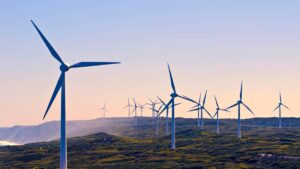Solar power to energise Alice Springs, coal gives way to renewables

Solar power and renewable energies are edging aside coal in a low carbon trend for electricity: Getty Images
Alice Springs, the outback town that is the gateway to Uluru in the Northern Territory has been chosen for a two-year, $9.3m renewable energy project partly funded by the federal government.
The Alice Springs Future Grid project will provide practical solutions to getting more renewable energy into the local electricity network.
Only 10 per cent of Alice Springs’ electricity is generated from renewable sources, and there are issues in powering the 30,000-strong town and its surrounding communities.
The government’s Australian Renewable Energy Agency (ARENA) is providing $2.17m of funding toward the project that will address technical, regulatory, social and economic factors affecting Alice Spring’s electricity grid.
“This project will lead to the development of a tangible roadmap for increased renewable energy adoption in Alice Springs,” ARENA chief executive Darren Miller said.
The overall project is broken down into smaller individual projects that include, a large-scale battery system for the town, and a residential battery trial for 50 customers.
The project team will investigate commercial and other incentives to encourage a greater take up of household batteries connected to rooftop solar panels.
‘Small enough to manage, big enough to matter’
A steering committee of the CSIRO, the Power and Water Corporation and Territory Generation, along with Northern Territory government representatives are overseeing the project.
The Intyalheme Centre for Future Energy is leading the Alice Springs Future Grid project.
“Alice Springs is small enough to manage but big enough to matter, and we are confident the project will not only help secure a clean and reliable energy future for the town, but the knowledge generated will have a positive flow-on effect, well beyond the other isolated networks in the Northern Territory,” Tristan Simons, general manager of the Intyalheme Centre, said.
Intyalheme means ‘a fire flaring up again’ and the centre is a flagship project of Desert Knowledge Australia, which has expertise in solar energy. Its Alice Springs’ demonstration facility – The Solar Centre – is the largest in the southern hemisphere.
The Desert Knowledge Centre received $3.19m of funding from ARENA as part of the federal government’s $50m Regional and Remote Communities Microgrid Fund.
Coal loses out to renewables worldwide
Meanwhile, research shows that electricity generated from wind turbines and solar farms has doubled its share of the power generation market in the past five years.
Solar and wind generated-electricity made up 10 per cent of world power output in the first half of 2020, according to UK environmental group Ember, Bloomberg news reported.
This is up from only 4.6 per cent for solar and wind power in 2015.
Ember analysed data from 48 countries that account for 83 per cent of world electricity generation, and its research revealed that wind and solar power generation increased significantly in the January-June period.
Solar and wind generation’s gain in the power mix came at the expense of coal-fired power production, which globally has fallen to 33 per cent in 2020 from 38 per cent in 2015.
European countries and the US have dramatically cut their use of coal-fired power generation, while China and India have expanded their coal-fired electricity output.
China makes up 54 per cent of the world’s power generation from coal, up from 44 per cent in 2015, Bloomberg reported.
Even in China renewable sources of electricity accounted for 10 per cent of the country’s generation.
COVID accelerates shift to renewables
Lux Research, a tech-solutions advisory firm based in the US, said in a report this week that COVID-19 would accelerate the transition in economies to low and zero carbon emission technologies.
“The aftermath of COVID-19 will shake the economic fabric of the energy sector,” Lux Research senior analyst Yuan-Sheng Yu said.
In the past six months, unprecedented events have occurred in the world’s energy markets, including negative oil futures prices, US renewable energy output exceeding that for coal, and the largest fall in carbon dioxide emissions, Yu said.
Countries are taking measures to accelerate their economies transition to low carbon emissions technology as a result of economic changes forced by COVID-19.
“The pandemic highlighted the risks of disruptions to our current energy infrastructure and supply chain,” Lux Research analyst Tim Grejtak said.
“In response, we will see aggressive diversification of business portfolios to avoid the risk of under-utilised and eventually stranded assets in order to capitalise on opportunities provided by increasing renewable energies.”
Related Topics

UNLOCK INSIGHTS
Discover the untold stories of emerging ASX stocks.
Daily news and expert analysis, it's free to subscribe.
By proceeding, you confirm you understand that we handle personal information in accordance with our Privacy Policy.








